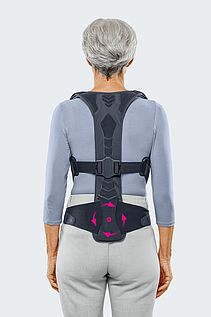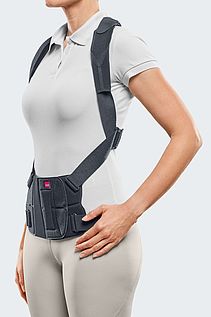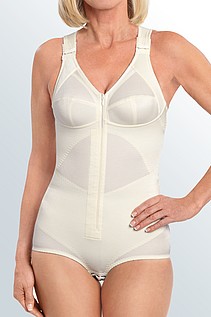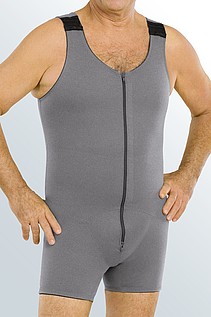Spinomed orthoses for osteoporotic vertebral fractures
Spinomed back orthoses are used in the treatment of osteoporosis, in cases of kyphosis with chronic back pain, and in juvenile Scheuermann’s disease. The therapy guidelines of the German Osteology Society recommend the use of spine-straightening orthoses like Spinomed in osteoporosis treatment.1 Spinomed orthoses are particularly suitable for patients following an osteoporotic vertebral fracture.
While the Spinomed is available in a backpack-style version, the Spinomed active and Spinomed active men are body-style orthoses designed to be worn discreetly under clothing. By the way: medi is the market leader for spine-straightening back orthoses in Germany.
-

Spinomed® Back orthosis for vertebral extension in osteoporosis
Size- XS
- S
- M
- L
- XL
- XXL
- Grey
-

Spinomed® II Back orthosis
Size- XS
- S
- M
- L
- Silver
-

Spinomed® active Back orthosis for vertebral extension for active relief
Colours- Black
- Champagne
-

Spinomed® active men Back orthosis for vertebral extension for active relief
Colours- Grey
The mechanism of action of Spinomed back orthoses
Effective osteoporosis therapy with Spinomed back orthoses is characterized by high wearing comfort and a biofeedback-based mechanism of action: Thanks to the shoulder strap system and back splint, the orthoses gently remind osteoporosis patients to actively straighten into correct posture again and again. The effectiveness of these osteoporosis orthoses has been demonstrated in clinical studies.2, 3, 4 The results: Spinomed back orthoses reduce pain, strengthen core muscles, and improve upper body posture. This leads to increased well-being and mobility in everyday life.
In a representative patient survey5, individuals with osteoporosis described the perceived benefits of Spinomed back orthoses: Around two-thirds reported improved mobility or enhanced quality of life, along with high wearing comfort. More than half experienced pain relief from wearing their orthosis. If medically necessary, a back orthosis can be prescribed by a physician.
Sources:
1 DVO. Prophylaxe, Diagnostik und Therapie der Osteoporose bei postmenopausalen Frauen und bei Männern ab dem 50. Lebensjahr 2023. Online veröffentlicht unter: https://register.awmf.org/de/leitlinien/detail/183-001 (Letzter Zugriff 10.10.2024).
2 Pfeifer M et al. Effects of a New Spinal Orthosis on Posture, Trunk Strength, and Quality of Life in Women with Postmenopausal Osteoporosis: A Randomized Trial Am J Phys Med Rehabil 2004; 83(3):177-186.
3 Hettchen M et al. Effects of the “Spinomed active” orthosis on chronic back pain in kyphotic women with osteoporotic vertebral fractures three months and older: A randomized controlled study. Front. Pain Res. 3:1038269.
4 Genest F et al. Feasibility of simple exercise interventions for men with osteoporosis – A prospective randomized controlled pilot study. Bone Rep. 2021;15:101099.
5 medi GmbH & Co. KG. Repräsentative Umfrage mit über 300 Osteoporose-Patient:innen bestätigt Nutzen einer wirbelsäulenaufrichtenden Orthese. Online veröffentlicht unter: https://images.medi.de/Storage/Documents/Deutschland/Spinomed-Repraesentative-Umfrage-mit-Osteoporose-Patienten-2021-08.pdf (Letzter Zugriff 14.10.2024).

